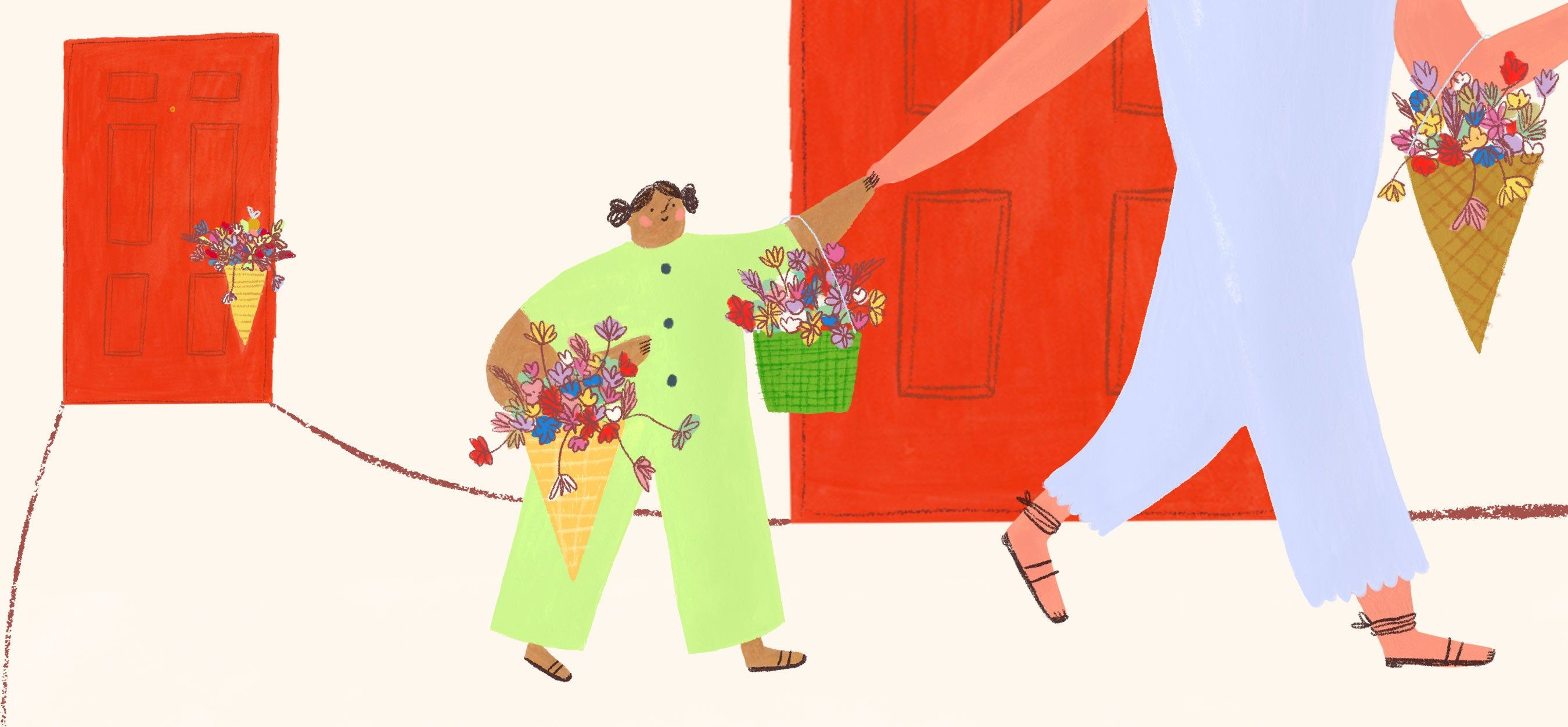
Everyday Magic
Everyday Magic: The Neighborly Art of May Day Baskets
Journalist and folklorist Eleni N. Gage explores seasonal celebrations and ways to make parenting magic out of the mundane in a new column, Everyday Magic. Next up, the history of May Day baskets and ideas for sharing simple homemade versions – even if your spring blooms come from the bodega.
- Written By
- Eleni N.Gage
- Illustration
- Sarah Wilson
Proust had his madeleine to catapult him back into childhood memories; I have the self-check-out machine at Whole Foods. See, you can scan the bar code on packaged food, but you have to type in the category of fruit you’re buying: Apple, say, and then you choose between green and red, and then further by type, Macoun, Granny Smith, Organic Granny Smith. When I typed Strawberries, up popped images of several different containers; the very first one was the green plastic latticed basket I remembered from growing up in Massachusetts, back in the late eighties and early nineties.
I haven’t seen that slatted green basket in ten years at least—strawberries now seem to come in clear clamshells or cardboard containers. And while I’m all for the latter (the less plastic, the better), I couldn’t stop grinning at the sight of that green basket. Because looking at the picture, I remembered: The plastic lattices were perfect for threading ribbons in between, something my mother, sister, and I did before filling baskets with flowers and dropping them off in front of our neighbors’ front doors on May first.
My mom called them “May baskets,” and said she used to do the same thing, growing up in Minnesota in the 40s and 50s. I remember leaving the May Day baskets as a hilarious door-and-dash; we’d ring the bell, then run away, laughing. But the preparation was just as fun—hoarding ribbons, threading them through the saved and carefully washed berry baskets, then picking wildflowers and choice specimens from our garden to fill them.
As I lugged my groceries home from Whole Foods, my nostalgic glee turned to gloom. Now that I’d remembered May Day baskets, I wanted to make them with my own kids. But if I can’t find berry baskets, although they must exist in some supermarket somewhere, according to the all-knowing self-check-out registers, then how can I recreate the May magic?
Searching for solutions, I came across an NPR article that cited a 1932 newspaper describing young people making May baskets out of wallpaper samples. It also quoted an Illinois reporter, writing in 1871, as saying: “A May-basket is … something to be hung on a door. Made of paper generally, it contains almost anything, by way of small presents you have in mind to put in it, together with your respects, best wishes — love, perhaps. It is hung after dark at the door of anybody the hanger fancies. — Which done, the said hanger knocks and scampers.”
While my mother was, clearly, a genius for realizing the potential in a plastic berry basket, the article convinced me that May Day baskets can be crafted out of anything, as long as you’ve got crayons and stickers and ribbons to decorate them; the main ingredient is the element of surprise—and, of course, the scampering. I also loved the romance angle; other quotes from old newspapers made it clear that boys and girls, even way back when, could leave a bouquet for their crush, who would then run out the door to try and catch the person who fancied them. May Day baskets, it seems, are about Spring fever, and there’s plenty of that to go around even when berry containers are scarce.
Some folklorists trace May Day baskets back to Beltane, the Gaelic welcome-summer festival held around May first, halfway between the spring equinox and the summer solstice. A fertility festival meant to encourage crop growth and protect cattle, people, and property from mischievous fairies, Beltane was celebrated with bonfires, parties, and the decorating of doors, windowsills, and even livestock with bunches of Spring flowers. That’s where I stumbled against another obstacle to my plans. May Day baskets are all about Spring fever, sure, but they’re also about wildflowers.
While wildflowers were abundant in suburban Massachusetts, where I grew up, they are in short supply in our Manhattan apartment. The few decidedly un-wild blooms on our windowsill won’t get us very far, and I’ve spent most of the seven years of Nico’s childhood trying to teach him not to pick flowers in the park so that everyone can enjoy them.
The solution to my dilemma appeared, as one often does in New York, in the local bodega. These days, when I walk my kids home from school, I find myself forcing them to stop and bask in the scent of hyacinths every time we pass the bodega, its shelves stocked with Spring flowers of all kinds and colors. Clearly, May Day is my chance to support the shop’s floral efforts, which bring so much joy to me—if not to my kids, who don’t seem to love the forced basking. (Too bad, though, because that’s what motherhood is all about—teaching kids to appreciate this world whether they want to or not.)
So, now we have a plan. Our baskets may be made of construction paper, or popsicle sticks, or paper shopping bags—we’re experimenting. And they may be filled with paper flowers, and notes, and just a few prize bodega options. But I know exactly whose doorknobs we’ll hang them on: our friends from pre-K on the 8th floor of our high-rise, and Mary, on the 9th, a grandmotherly woman who once caught me reading a mystery in the elevator, then dropped off bags of what she called her “pandemic pile” of paperbacks she’d gone through during quarantine. Ten-year-old Amalia and I are both devoted mystery fans, and now, following Mary’s lead, we leave books we’ve read on her doorstep. It’s an inter-building book exchange, or, maybe, a literary take on May Day. Because in the end, May Day is really about saying, “We thought you’d enjoy this.” Also, “Look, it’s Spring! Isn’t the world beautiful?” And, “We’re glad that you’re in it with us.”
Eleni N. Gage

Journalist, folklorist, and mother of Greekaraguans, Eleni N. Gage is the author of two novels, a travel memoir, and the gift book Lucky in Love: Traditions, Customs, & Rituals to Personalize Your Wedding.